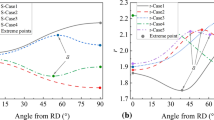Abstract
Hill’48 yield function has been widely used to describe the anisotropic behaviors of material in FE simulation of tube and sheet metal forming process. To obtain the material behaviors of small-sized H96 brass extrusion double-ridged rectangular tube (DRRT) in bending process, an inverse method combining response surface method and three-point bending was proposed to identify the parameters of Hill’48 yield function. It was found that comparing with Hill’48 yield function only considering the normal anisotropy and Mises yield function, Hill’48 yield function with the identified parameters performs the best in reproducing the material behavior of H96 brass DRRT in three-point bending process. And then Hill’48 yield function with the identified parameters was also adopted in the FE simulations of rotary draw bending of DRRT. It was observed that the prediction accuracy of cross sectional deformation of DRRT in rotary bending process was improved effectively by using Hill’48 yield function with the identified parameters. This proves that the proposed inverse method is suitable to the real forming process.








Similar content being viewed by others
References
O.S. Hopperstad, T. Berstad, H. Ilstad, O.G. Lademo, and M. Langseth: Effects of the yield criterion on local deformations in numerical simulation of profile forming. J. Mater. Process. Technol. 80–81, 551–555 (1998).
M. Zhan, T. Huang, and H. Yang: Variation of contractile strain ratio of Ti–3Al–2.5V tubes and its effects in tubes numerical control bending process. J. Mater. Process. Technol. 217, 165–183 (2014).
S. Cooreman, D. Lecompte, H. Sol, J. Vantomme, and D. Debruyne: Identification of mechanical material behavior through inverse modeling and DIC. Exp. Mech. 48, 421–433 (2008).
A. Güner, C. Soyarslan, A. Brosius, and A.E. Tekkaya: Characterization of anisotropy of sheet metals employing inhomogeneous strain fields for Yld2000-2D yield function. Int. J. Solids Struct. 49, 3517–3527 (2012).
N. Tardif and S. Kyriakides: Determination of anisotropy and material hardening for aluminum sheet metal. Int. J. Solids Struct. 49, 3496–3506 (2012).
S. Cooreman, D. Lecompte, H. Sol, J. Vantomme, and D. Debruyne: Elasto-plastic material parameter identification by inverse methods: Calculation of the sensitivity matrix. Int. J. Solids Struct. 44, 4329–4341 (2007).
O. Ghouati and J.C. Gelin: Identification of material parameters directly from metal forming processes. J. Mater. Process. Technol. 80–81, 560–564 (1998).
A. Chamekh, H.B.H. Salah, and R. Hambli: Inverse technique identification of material parameters using finite element and neural network computation. Int. J. Adv. Manuf. Technol. 44, 173–179 (2009).
A. Malakizadi, S. Cedergren, I. Sadik, and L. Nyborg: Inverse identification of flow stress in metal cutting process using response surface methodology. Simul. Model. Pract. Th. 60, 40–53 (2016).
E. Huber and N. Tyulyukovskiyand: Identification of viscoplastic material parameters from spherical indentation data: Part I. Neural networks. J. Mater. Res. 21, 664–676 (2006).
A. Malakizadi, I. Sadik, and L. Nyborg: Wear mechanism of CBN inserts during machining of bimetal aluminum-grey cast iron engine block. Procedia CIRP 8, 188–193 (2013).
R. Hill: A theory of the yielding and plastic flow of anisotropic metals. Proc. R. Soc. London 193, 281–297 (1948).
Y. Yan, H. Wang, and Q. Li: The inverse parameter identification of Hill 48 yield criterion and its verification in press bending and roll forming process simulations. J. Manuf. Processes 20, 46–53 (2015).
M. Bäker and A. Shrot: Inverse parameter identification with finite element simulations using knowledge-based descriptors. Comput. Mater. Sci. 69, 128–136 (2013).
J. Cao and J. Lin: A study on formulation of objective functions for determining material models. Int. J. Mech. Sci. 50, 193–204 (2008).
ACKNOWLEDGMENTS
The authors would like to thank the National Natural Science Foundation of China (No. 51375392) and the Research Fund of the State Key Laboratory of Solidification Processing (NWPU), China (No. 152-ZH-2016) for the support given to this research.
Author information
Authors and Affiliations
Corresponding author
Rights and permissions
About this article
Cite this article
Zhang, H., Liu, Y. The inverse parameter identification of Hill’48 yield function for small-sized tube combining response surface methodology and three-point bending. Journal of Materials Research 32, 2343–2351 (2017). https://doi.org/10.1557/jmr.2017.82
Received:
Accepted:
Published:
Issue Date:
DOI: https://doi.org/10.1557/jmr.2017.82



